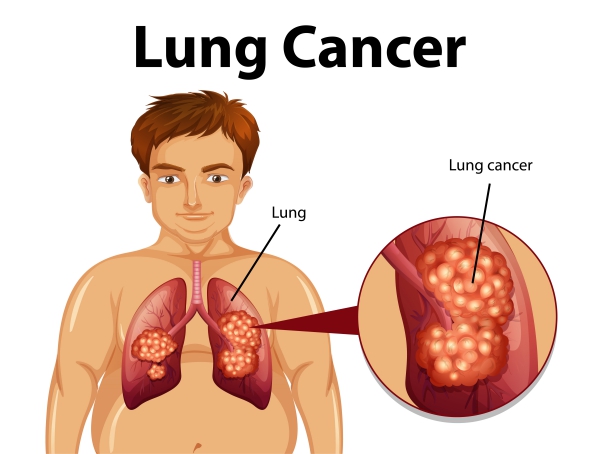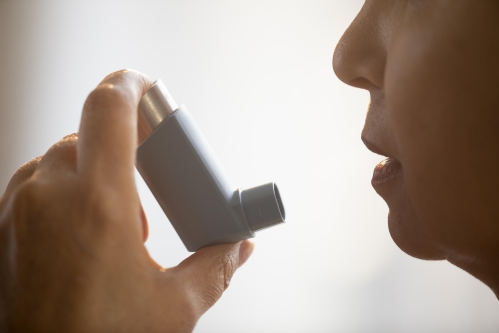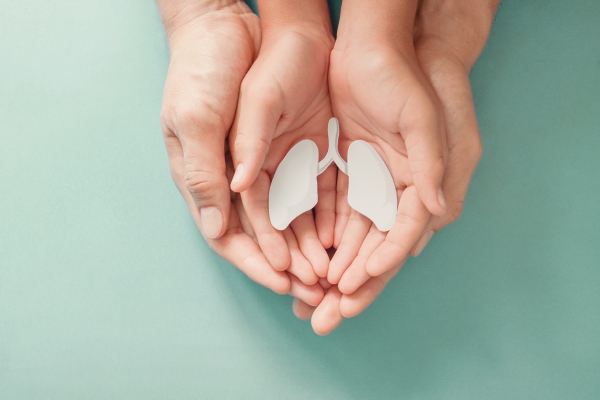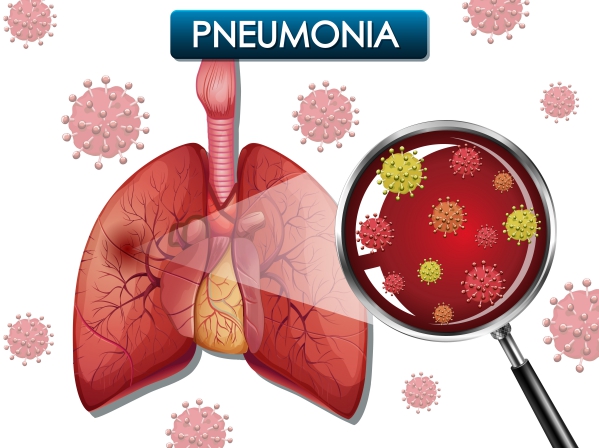What is lung cancer?
Lung cancer is a cancer that affects your lungs. The lungs are responsible for gaseous exchange- when you breathe in you take in oxygen and when you breathe out you take out carbon dioxide.
85% of lung cancer is due to non-small cell lung cancer. In the United States, lung cancer is the second most common cancer and the most common cause of cancer deaths. By 2020, the American Cancer Society projects that around 228, 000 people will be affected by lung cancer. In addition, the lung cancer death rate is higher in men than women. Furthermore, it most commonly occurs in people aged between 50 to 70 years.
What are the risk factors for lung cancer?
The risk factors for lung cancer include:
- Smoking: your risk of developing lung cancer increases with the number of cigarettes you smoked per day and the number of years you have been smoking. Smoking cessation at any age significantly reduces your risk of developing lung cancer.
- Passive smoking: being exposed to second-hand smoke, even if you do not smoke cigarettes yourself, can increase your risk of developing lung cancer.
- Family history of lung cancer: having a parent or sibling with lung cancer increases your risk of developing lung cancer.
- Previous radiation therapy: if you have done radiation therapy to the chest previously, you are at an increased risk of developing lung cancer.
- Asbestos exposure: being exposed to asbestos, which can found at some workplace, can increase your risk of developing lung cancer.
- Radon gas exposure: radon gas is a naturally existing radioactive gas and being exposed to an elevated level of the gas can increase your risk of developing lung cancer. Radon gas is produced during the breakdown of uranium in soil, rocks and water that eventually evaporates into the air.
- Other carcinogenic substances: arsenic, cadmium, nickel, chromium and uranium amongst others can increase your risk of developing lung cancer.

What are the signs and symptoms of lung cancer?
Early stages of lung cancer does not result in any symptoms. However, as the cancer continues to grow, the following signs and symptoms may ensue:
- A persistent cough that remains after 2-3 weeks and worsens progressively.
- Coughing up blood (haemoptysis).
- Recurrent chest infections.
- Pain during deep breathing and coughing.
- Persistent shortness of breath.
- Lack of energy.
- Unintentional weight loss.
- Loss of appetite.
- Hoarseness of voice.
- Finger clubbing- your finger nails become more curved.
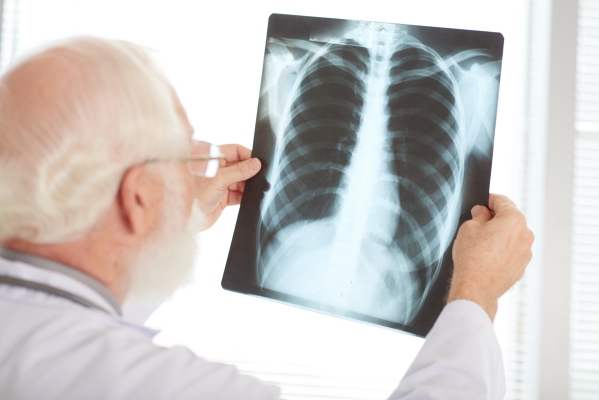
Making a diagnosis
 After taking a detailed history from you to know more about your symptoms, your doctor will perform a physical examination to look for signs of lung cancer. In addition, several tests can be used to confirm the diagnosis and these include:
After taking a detailed history from you to know more about your symptoms, your doctor will perform a physical examination to look for signs of lung cancer. In addition, several tests can be used to confirm the diagnosis and these include:
- Chest x-ray: this is usually the first test that is used to confirm the diagnosis of lung cancer. The cancer may be seen as a white-grey opaque mass. However, this test cannot be used to get a definitive diagnosis as it cannot differentiate between lung cancer and lung abscess- a collection of pus within the lungs.
- Contrast-enhanced computed tomography (CT) scan: before the CT scan is taken, your doctor will give you an injection containing a dye which will improve the quality of the image. The CT scan provides a detailed image of your lungs and will detect with precision any mass within your lungs.
- Positron Emission Tomography- CT scan (PET-CT scan): if the previous CT scan shows early stage lung cancer, the PET-CT scan can localise the active cancer cells. A radioactive substance is injected for better imaging. The PET-CT scan will be used to confirm the diagnosis and guide the treatment strategy.
- Bronchoscopy and biopsy: if after the CT scan a mass is seen in the central part of your lungs, endoscopy might be an option. This technique allows your doctor to directly visualize the mass and take a few samples to be sent for laboratory investigations. The samples are analysed using a microscope to confirm the diagnosis of lung cancer and stage it.
- Percutaneous needle biopsy: before introducing a needle to reach the lung mass, local anaesthesia is used to numb your skin. A CT scanner is used as a guide to reach the mass.

What are the treatments for lung cancer?
There are several treatment strategies available for lung cancer. To decide which type of treatment will be used, your doctor will assess the type, size, position, and stage of the lung cancer plus your overall health. The treatment strategies of lung cancer include:
- Surgery: there are different types of surgeries which can be performed such as wedge resection, segmental resection, lobectomy and pneumonectomy. Wedge resection is the removal of a small section of your lung along with some healthy tissues at the margins. Segmental resection is the removal of a larger portion of your lung, not involving the entire lobe. Lobectomy is the removal of the entire lobe of one lung. Pneumonectomy is the complete removal of one of your lungs.
- Radiation therapy: Radiation therapy uses x-rays or protons to kill cancer cells. This type of treatment is used in people with locally advanced lung cancer. It can be used before or after surgery. It is often given along with chemotherapy, especially when surgery is not an option.
- Chemotherapy: chemotherapy is the use of drugs to kill cancer cells. The drugs can be given orally or intravenously. This treatment may last for several weeks or months. There are breaks in between each session to provide time for your body to recover. Chemotherapy is used before surgery to reduce the size of the mass and after surgery to kill any remaining cancer cells.
- Other therapies: targeted drug therapy and immunotherapy can also be used to treat lung cancer. Immunotherapy uses your own immune system to fight cancer cells.

What are the complications of lung cancer?
If lung Cancer is left untreated, several complications may arise such as:
- Pain: if the cancer has spread to your bone or lung lining, it can cause pain.
- Haemoptysis: this is the coughing up of blood which occurs when the mass grows in size, affecting the blood vessels in your lungs.
- Difficulty breathing: when the cancer enlarges, it may obstruct your airways leading to shortness of breath.
- Pleural effusion: lung cancer may cause accumulation of fluids in between your lungs and the chest cavity.
- Metastasis: this is when the cancer spreads to other parts of your body such as your bones or brain. It is one of the most feared complication of lung cancer. Unfortunately, once the cancer has spread, it commons incurable. However, palliative treatments are available to help relieve your symptoms.
Prevention
You can decrease your risk of developing lung cancer if you:
- Do not smoke cigarettes.
- Stop smoking.
- Do regular physical exercises.
- Eat a healthy diet rich in fruits and vegetables.
- Avoid passive smoking.
- Wear protective gear such as masks when exposed to carcinogenic gases at work.

Prognosis
Lung cancer is highly lethal and in the United States, the 5-year survival rate is around 19.4%. In addition, as the cancer spreads beyond the lungs, the prognosis decreases significantly. Furthermore, smoking cessation after the diagnosis of early stage lung cancer may improve the prognosis and even reduce cancer progression.

Source:
Parveen, K. and Michael, C., 2017. Kumar & Clark's Clinical Medicine. 9th ed. The Netherlands: ELSEVIER.
Tan, W., 2020. Non-Small Cell Lung Cancer (NSCLC).
NHS. 2020. Lung cancer.
